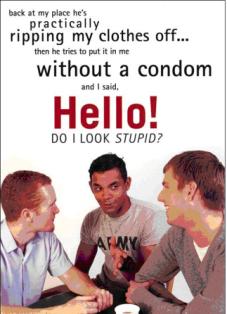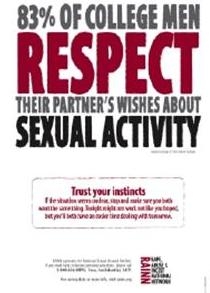|
Theory Informs the Message
When authorities warn you of the sinfulness of sex, there is an important lesson to be learned. Do not have sex with the authorities.
--Matt Groening
When developing an intervention or campaign it is wise to use theory to determine "why," "what," and "how" a health problem should be addressed.
-
Theory helps explain why people do or do not engage in certain health behaviors
-
Theory prioritizes what you need to know before developing public health programs
-
Theory informs how to devise program strategies that reach priority populations to assure a significant impact
Theory based program planning, implementation, and monitoring processes are more likely to be successful when compared to those without the assistance of a theoretical framework. Theory helps guide you through the evaluation process by identifying which indicators to monitor.
Before selecting a theory to help guide your campaign, you need to thoroughly assess:
- Your Community
- The Issue
- The Behavior you want to address
- How you will measure change in behavior
This section will review basic theories that can be applied to social marketing:
Transtheoretical Model (Stages of Change)
Health Belief Model
Theory of Planned Behavior and Theory of Reasoned Action
Social Cognitive Theory
Social Norms Theory
Why do we need theories?
Theory:
-
Provides a guide or framework for planning
-
Leads to more effective interventions
-
Informs models of change that are applicable in other settings
-
Explains "antecedents" to health behaviors
o Promotes better understanding of causes to behaviors
(leading to more effective programs)
o Helps identify groups at risk
How to select a theory: Choose a theory that best answers these questions:
-
What are primary causes of the health problem?
-
What are links between interventions and outcomes?
-
How do community, individual and societal factors interact?
-
What is the role of the health educator and other stakeholders?
Theory links activities to outcomes.
An effective intervention should have a coherent rationale - or a theoretical basis - for goals, intervention activities, and role of health educator.
No theory is perfect! Weaknesses of some health education theories may include:
-
Emphasis on individual change not on larger social or environmental factors
-
Intention to move population in a unidirectional or static way towards behavior change
-
A lack of participation from population
-
No explanation of the big picture - problems are within a cultural context
For more information on health change behavior theories, download Theory at a Glance, a wonderful resource which is available for FREE at the National Cancer Institute website.
Transtheoretical Model (Stages of Change):
Complex behavior change occurs over time and in small increments. The Stages of Change model describes a five stage process a person goes through to change a particular behavior. By determining which stage most of your priority population are in, appropriate messages can be designed to move them along in the next stage. Below are descriptions of the five stages:
Example: "I know I have a few sexual partners, but I don't
need to use condoms because my partners aren't at risk for
STDs or HIV."
Example: "I know that not using condoms may put me at risk
for STDs, HIV and maybe getting someone pregnant, but sex
isn't the same when I wear a condom."
- Preparation: Intention to take action in the immediate future (1 month); has plan of action.
Example: "I just bought some condoms and am going to talk to
my partner about using them the next time we have sex."
- Action: Overt action taken within the last 6 months.
Example: "My partner and I used a condom for the first time
and it wasn't as bad as I thought."
- Maintenance: Work to prevent relapse; less temptation and more confidence.
Example: "Using condoms is no big deal anymore; my partner
and I have our routine down and always use them when we
have sex."
Primary authors: Prochaska and DiClemente
Transtheoretical Model Example -- I Know. Campaign
Campaign: I Know
Los Angeles County STD Program
Audience: Young African American women and latinas
Issue: Chlamydia and Gonorrhea prevention
This campaign addresses an individual's behavior through the Transtheoretical Model. Specifically, these messages are aimed at the contemplation stage of the model. Generating contemplation of a behavior change will potentially lead a person to the next stage: preparation. The ad includes contact information for those who are motivated to make a plan and act on the message to get tested.
Health Belief Model
The Health Belief Model (HBM) speaks to an individual's perception of the threats posed by a health problem, the benefits of avoiding the health problem, and the factors that sway one's decision to act. The model suggests key constructs that influence an individual's decisions about whether or not to take action to prevent, screen for, and control a health problem.
An individual's health related behavior depends on the following:
- Perceived susceptibility: A person believes s/he is susceptible to the condition.
- Perceived severity: A person believes the condition has serious adverse consequences.
- Cue to action: A person is exposed to factors that prompt action.
- Self-efficacy: A person is confident in his/her ability to successfully perform a given action.
HBM is centered on health motivation, which makes it an effective theory for addressing behaviors that evoke health concerns; for example the possibility of contracting HIV is due to high risk sexual behavior.
Primary Author: Rosenstock
Health Belief Model -- Social Marketing Campaign example

Ad reads:
"It might seem like diarrhea is no biggie. That's probably 'cause you never had it like I have. Try shitting your guts out every day for weeks at a time. How about being terrified to go anywhere because you might crap your pants? Don't get me wrong. I'm really glad to be alive, but HIV is NO PICNIC. I don't care how good the sex is or how hot the guy is, nothing is worth what I'm going through now."
Stopaids.org -- STOP AIDS Project
The STOP AIDS Project launched a social marketing campaign, "HIV is No Picnic," designed to counter a widely held perception among HIV negative men that contracting HIV is no longer something to be so concerned about.
This campaign targets the Health Belief Model construct of perception of severity around contracting HIV.
Back to Top
Theory of Planned Behavior and Theory of Reasoned Action
These two associated theories explore the relationship between behavior and beliefs, attitudes and intentions. It is assumed that behavioral intention is the most important determinant of behavior. Behavioral intention is believed to be influenced by a person's attitude toward performing a behavior, and whether individuals who are important to the person approve or disapprove of the behavior. The two theories differ in that the Theory of Reasoned Action includes an additional construct, perceived behavioral control. It is argued that people might try harder to perform a behavior if they feel they have a high degree of potential for attaining success.
Primary Authors: Fishbein and Ajzen

Campaign: AIDS It Ain't Over Yet
AIDS Action Committee, Boston Public Health Commission
Audience: IDUs, Gay males, Transgenders, Youth Heterosexual Singles and Couples (Caucasian, Hispanic and African American)
Issue: HIV Prevention
In this ad, the message is that someone who doesn't use condoms is stupid. The main character in the ad is telling his friends about this incident and reaffirming his attitude that condoms are positive.
From the message and the image, we can see that the general attitude towards condoms is that they should be used and doing otherwise would be stupid. The group's attitude towards condoms is positive, thus their behavior reflects and is influenced by the group attitude.
Back to Top
Social Cognitive Theory
Social Cognitive Theory (SCT) explores the dynamic manner in which personal and environmental factors, and human behaviors influence each other. Within SCT, three primary factors affect the probability that a person will change a health behavior: self-efficacy, goals, and outcome expectancies. This theory includes many constructs because it integrates concepts and processes from cognitive and emotional models of behavior change.
Primary Authors: Miller, Dolland, Bandura
You Know Different campaign - National Youth Advocacy Coalition
The You Know Different social marketing campaign is a component of NYAC's National Youth HIV Testing Initiative and is designed for use on a local, grassroots level. It is ideal for organizations that conduct HIV outreach and education as a part of their HIV prevention efforts for young people.
The social marketing strategy is designed to integrate easily into other community outreach efforts and events. Campaign materials (posters, palm cards, stickers, and web components) can be easily disseminated. While the campaign was designed for organizations to partner with others in their community, organizations with the capacity can implement the campaign on their own. The strategy has been successfully pilot tested in community coalitions consisting of local providers in Washington, DC, Bronx, NY and Florida.
NYAC also provides a toolkit about creating social marketing campaigns to increase HIV testing among teens. Click here to download the PDF.
Back to Top
Social norms theory states that interventions designed to correct misperceptions of norms by revealing the actual, healthier norm (of behaviors) will have a beneficial effect on most individuals. When given information about the healthy norm, people will either reduce their participation in potentially problematic behavior or be encouraged to engage in protective, healthy behaviors. Whether or not they engage in the behavior, all individuals who misperceive the norm contribute to the climate that allows the behavior to occur and continue. Thus, interventions based on social norms attempt to correct the misperceptions of all community members, whether they actually engage in the problem behavior or not. This model has been particularly successful in developing effective drug and sexual assault prevention strategies, racial identity theory, and men's responsibility for preventing sexual assault.
Primary Author: Berkowitz

RAINN's Social Norms Poster Campaign
Engaging Men in the Prevention of Sexual Assault
http://www.rainn.org/
This campaign utilized messages aimed at moving small communities to adopt healthy social norms. The message in the poster is aimed at men to inform them that the vast majority of men do not commit assault and rape; the social norm is to respect their partner's wishes about sexual activity. This message helps to create a climate where sexual assault is socially unacceptable.
NEXT PAGE
PREVIOUS PAGE
|